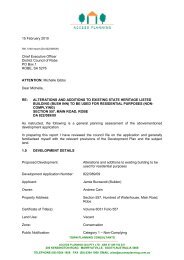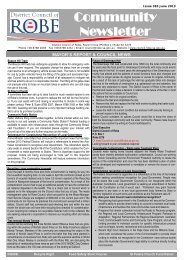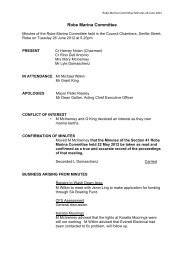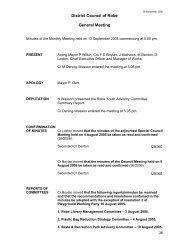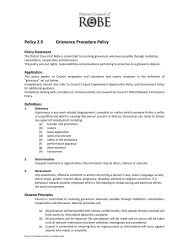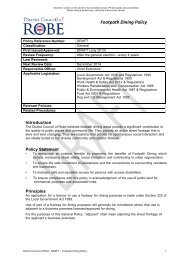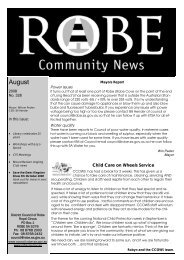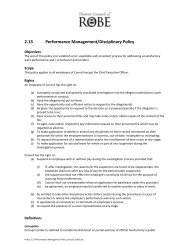Trouble in China China in the 1850's was a poverty stricken ... - Robe
Trouble in China China in the 1850's was a poverty stricken ... - Robe
Trouble in China China in the 1850's was a poverty stricken ... - Robe
You also want an ePaper? Increase the reach of your titles
YUMPU automatically turns print PDFs into web optimized ePapers that Google loves.
<strong>Trouble</strong> <strong>in</strong> Ch<strong>in</strong>a<br />
Ch<strong>in</strong>a <strong>in</strong> <strong>the</strong> 1850’s <strong>was</strong> a <strong>poverty</strong> <strong>stricken</strong>, violent place. A series of upheavals <strong>in</strong>clud<strong>in</strong>g political<br />
rebellions, drought and <strong>the</strong> soporific effect of opium addiction had transformed this cultured and<br />
dignified land <strong>in</strong>to a fam<strong>in</strong>e-ridden <strong>was</strong>teland 1<br />
. Overpopulation <strong>was</strong> ano<strong>the</strong>r problem and Ch<strong>in</strong>ese<br />
families found it impossible to achieve prosperity and security no matter how hard <strong>the</strong>y were prepared<br />
to work. As loyalty to family <strong>was</strong> <strong>the</strong> strongest cultural value, <strong>the</strong>y looked abroad for opportunities to<br />
earn and send monies home to <strong>the</strong>ir families ra<strong>the</strong>r than to leave <strong>the</strong>ir homeland permanently. They<br />
were sojourners not immigrants.<br />
The Ch<strong>in</strong>ese had for some years been lured to <strong>the</strong> Californian Goldfields by <strong>the</strong> promise of gold. Here<br />
any man could take his chances and work hard to uncover <strong>the</strong> riches of <strong>the</strong> earth that were available to<br />
all. They were diligent, quiet workers but <strong>the</strong>ir looks and habits that were unfamiliar to <strong>the</strong> Americans,<br />
made <strong>the</strong>m unpopular at <strong>the</strong> Californian goldfields. The threat of violence <strong>was</strong> ever present. Eighty-two<br />
Ch<strong>in</strong>ese m<strong>in</strong>ers were murdered <strong>in</strong> California between 1853 and 1854. Only two murderers were charged<br />
for <strong>the</strong>se crimes. It <strong>was</strong> hard to make a conviction, as evidence from a Ch<strong>in</strong>ese person <strong>was</strong> declared<br />
<strong>in</strong>admissible by Californian courts. In 1853, Ch<strong>in</strong>ese passengers who had arrived at <strong>the</strong> Californian<br />
goldfields after sail<strong>in</strong>g on <strong>the</strong> ships Brant, Lighten<strong>in</strong>g and North Carol<strong>in</strong>a were immediately driven off <strong>the</strong><br />
goldfields by <strong>the</strong> Americans.<br />
Gold strike <strong>in</strong> Victoria<br />
Around <strong>the</strong> end of 1852, <strong>the</strong> bloody Taipang rebellion started and it soon devastated Sou<strong>the</strong>rn and<br />
Central Ch<strong>in</strong>a. Dur<strong>in</strong>g this terrible period, more than 600 cities were destroyed <strong>in</strong> seventeen prov<strong>in</strong>ces.<br />
About 130 million Ch<strong>in</strong>ese people were slaughtered <strong>in</strong> <strong>the</strong> conflict or died from disease or starvation.<br />
Meanwhile <strong>in</strong> Victoria, a Ch<strong>in</strong>ese immigrant to Australia, Louis Ah Mouy, responded to <strong>the</strong> opportunity<br />
to strike it rich when gold <strong>was</strong> discovered <strong>in</strong> Yea. Louis wrote to his bro<strong>the</strong>r <strong>in</strong> Canton encourag<strong>in</strong>g him<br />
2<br />
to come to Australia and make <strong>the</strong>ir family’s fortune . The news of <strong>the</strong> Victorian gold strike spread like<br />
wildfire encouraged by Ch<strong>in</strong>ese agents <strong>in</strong> partnership with <strong>the</strong> capta<strong>in</strong>s of <strong>the</strong> foreign ships. They<br />
promoted <strong>the</strong> news throughout <strong>the</strong> Ch<strong>in</strong>ese tea houses. In January 1853, <strong>the</strong> first two shiploads of<br />
Ch<strong>in</strong>ese goldseekers arrived <strong>in</strong> Victoria. The Australian gold strike <strong>was</strong> <strong>the</strong> opportunity that <strong>the</strong>y had<br />
been wait<strong>in</strong>g for and by 1854, 3,000 Ch<strong>in</strong>ese m<strong>in</strong>ers had arrived <strong>in</strong> Victoria head<strong>in</strong>g straight to <strong>the</strong><br />
goldfields at Ballarat, Bendigo and Mt Alexander 3<br />
.<br />
Fund<strong>in</strong>g <strong>the</strong> passage<br />
How could <strong>the</strong> would-be m<strong>in</strong>ers liv<strong>in</strong>g <strong>in</strong> a <strong>poverty</strong>-<strong>stricken</strong> land afford to travel to Australia? The fare<br />
for <strong>the</strong> voyage of £10-12 had to be found, as well as money for fees, food and o<strong>the</strong>r provisions once<br />
<strong>the</strong>y had arrived. Only about a third of <strong>the</strong> Ch<strong>in</strong>ese who took <strong>the</strong> trip to <strong>the</strong> goldfields had <strong>the</strong> money for<br />
<strong>the</strong> fare, with <strong>the</strong> rest tak<strong>in</strong>g out loans. The m<strong>in</strong>ers considered it <strong>was</strong> not risky to borrow that fare as <strong>the</strong><br />
Ch<strong>in</strong>a ship’s agents spoke of limitless opportunities to repay <strong>the</strong> loan, amass great wealth and come<br />
home <strong>in</strong> glory. To entice <strong>the</strong>m to take out <strong>the</strong> loans, <strong>the</strong> ship’s agents paid ostensibly <strong>in</strong>dependent idlers<br />
4<br />
to follow <strong>the</strong>m through <strong>the</strong> teahouses a week later and confirm <strong>the</strong> agents’ stories . The m<strong>in</strong>ers were<br />
fur<strong>the</strong>r conv<strong>in</strong>ces by <strong>the</strong> popular stories of strik<strong>in</strong>g it rich on <strong>the</strong> goldfields and <strong>the</strong> folk songs of <strong>the</strong> time<br />
re<strong>in</strong>forced this message with lyrics such as Marry your daughter to a Gold Mounta<strong>in</strong> guest; when his ship<br />
comes home he will br<strong>in</strong>g a fortune 5<br />
. The loans were raised with families, village elders, banks and <strong>the</strong><br />
unscrupulous agents. The contract <strong>was</strong> such that <strong>the</strong> loan would be paid back on <strong>the</strong> ch<strong>in</strong>aman’s return<br />
toge<strong>the</strong>r with a third share of <strong>the</strong> gold he had m<strong>in</strong>ed. Security <strong>was</strong> required, and usually <strong>the</strong> borrower<br />
had no land as security. This meant <strong>the</strong> Ch<strong>in</strong>aman’s family, <strong>in</strong>clud<strong>in</strong>g his wife and children, became<br />
<strong>in</strong>dentured labor and were required to work off <strong>the</strong> loan for its duration. This <strong>was</strong> about two years and<br />
1 The Walk From <strong>Robe</strong>, 2 nd Edition 2002, Golden Dragon Museum, Bendigo, Victoria, page 5<br />
2 Sprengal Wilf; <strong>Robe</strong>’s Ch<strong>in</strong>ese Invasion, 1986, Hansen Pr<strong>in</strong>t, Naracoorte, South Australia, page 5<br />
3 The Walk From <strong>Robe</strong>, 2 nd Edition 2002, Golden Dragon Museum, Bendigo, Victoria, page 5<br />
4 The Walk From <strong>Robe</strong>, 2 nd Edition 2002, Golden Dragon Museum, Bendigo, Victoria, page 6<br />
5 Rolls, Eric; Sojourners; Flowers & <strong>the</strong> Wide Sea, 1992, University of Queensland Press, St Lucia, Queensland, page<br />
116
would f<strong>in</strong>ish when <strong>the</strong> goldseeker returned with his gold. If <strong>the</strong> m<strong>in</strong>der did not return <strong>in</strong> <strong>the</strong> time<br />
specified <strong>in</strong> <strong>the</strong> loan agreement, <strong>the</strong> m<strong>in</strong>er’s family would be sold and <strong>the</strong>n cont<strong>in</strong>ue to work off <strong>the</strong> loan<br />
until it <strong>was</strong> repaid.<br />
Preparation for <strong>the</strong> Journey<br />
In <strong>the</strong> beg<strong>in</strong>n<strong>in</strong>g, most of <strong>the</strong> m<strong>in</strong>ers were young, s<strong>in</strong>gle men who were sent by <strong>the</strong>ir families as under<br />
Confucian pr<strong>in</strong>ciples <strong>the</strong>y were required to obey <strong>the</strong>ir fa<strong>the</strong>rs and owed allegiance to <strong>the</strong>ir family. The<br />
families expected that once <strong>the</strong> m<strong>in</strong>er has amassed to <strong>the</strong>ir quick fortune, he would return home to <strong>the</strong><br />
village where he would purchase land for <strong>the</strong> family, build local schools, and build magnificent temples<br />
honour<strong>in</strong>g <strong>the</strong>m. Whole villages were <strong>in</strong>volved send<strong>in</strong>g off <strong>the</strong> prospectors, amass<strong>in</strong>g <strong>the</strong> garb and<br />
provisions needed for <strong>the</strong> journey. For <strong>the</strong> voyage on some Ch<strong>in</strong>a ships, <strong>the</strong>y needed to provide <strong>the</strong>ir<br />
own bedd<strong>in</strong>g and rations, which <strong>in</strong>cluded rice, dried and salt fish, dried vegetables and smoked and<br />
pickled duck. These m<strong>in</strong>ers would need suitable work<strong>in</strong>g cloth<strong>in</strong>g, bedd<strong>in</strong>g, cook<strong>in</strong>g pots, and<br />
prospect<strong>in</strong>g pans and shovels for <strong>the</strong> goldfields. All <strong>the</strong>se supplies had to be acquired <strong>in</strong> Ch<strong>in</strong>a while food<br />
and perishables for <strong>the</strong> goldfields would be purchased on arrival. They also wanted to reach <strong>the</strong><br />
goldfields as soon as <strong>the</strong>y could after arriv<strong>in</strong>g <strong>in</strong> Australia, without <strong>the</strong> delay of work<strong>in</strong>g to buy<br />
provisions, so <strong>the</strong>y accumulated money and items for trade to br<strong>in</strong>g with <strong>the</strong>m. These <strong>in</strong>cluded <strong>the</strong> holey<br />
dollars used as currency <strong>in</strong> <strong>the</strong>ir homeland, silver, and items for trade such as <strong>in</strong>laid chests, g<strong>in</strong>ger jars,<br />
silks, toys and opium.<br />
The preparations and <strong>the</strong> journey ahead were a massive undertak<strong>in</strong>g and would have been<br />
<strong>in</strong>comprehensible for <strong>the</strong>se little travelled villagers. So, <strong>the</strong> m<strong>in</strong>ers formed well-organised groups where<br />
toge<strong>the</strong>r <strong>the</strong>y planned and prepared for <strong>the</strong> journey. These groups travelled toge<strong>the</strong>r, establish<strong>in</strong>g rules<br />
and objectives for <strong>the</strong> members of <strong>the</strong> group to observe and support each o<strong>the</strong>r. The group often<br />
appo<strong>in</strong>ted a Headman who <strong>was</strong> usually educated and spoke some English, probably learned <strong>in</strong> Canton,<br />
which <strong>was</strong> an open port to <strong>the</strong> English. The Headman’s role <strong>was</strong> to accompany <strong>the</strong> group as an<br />
organiser, negotiator and <strong>in</strong>terpreter. He <strong>was</strong> to deal with <strong>the</strong> authorities and ships capta<strong>in</strong>s, negotiate<br />
<strong>the</strong> purchase of provisions and <strong>the</strong> services of Australian guides and to act as a debt collector if<br />
required 6<br />
.<br />
From Village to Ship<br />
The journey to <strong>the</strong> goldfields started long before <strong>the</strong> ships bear<strong>in</strong>g <strong>the</strong> Ch<strong>in</strong>ese reached Australia. First<br />
<strong>the</strong> goldseekers had to trek from <strong>the</strong>ir villages, which were ma<strong>in</strong>ly <strong>in</strong> <strong>the</strong> Sze Zap and Guangdong<br />
prov<strong>in</strong>ces, to <strong>the</strong> ports of Amoy and Canton. This took up to three days. There <strong>the</strong>y were transported on<br />
7<br />
overcrowded junks to Hong Kong . Once <strong>in</strong> Hong Kong, <strong>the</strong> bewildered travelers, many of whom had<br />
never ventured far from <strong>the</strong>ir villages before, were accommodated <strong>in</strong> wretched, agent run shanties<br />
while <strong>the</strong>y waited to jo<strong>in</strong> <strong>the</strong>ir foreign ship. Some of <strong>the</strong> travelers were frightened and wanted to<br />
abandon <strong>the</strong> venture, so <strong>the</strong> agents lured <strong>the</strong>m fur<strong>the</strong>r <strong>in</strong>to debt by <strong>in</strong>troduc<strong>in</strong>g <strong>the</strong>m to <strong>the</strong> vices of<br />
gambl<strong>in</strong>g and opium addiction. This meant <strong>the</strong> m<strong>in</strong>ers had even less chance or repay<strong>in</strong>g <strong>the</strong> loans <strong>the</strong>y<br />
had raised. If <strong>the</strong>y <strong>the</strong>n failed to undertake <strong>the</strong> journey, <strong>the</strong>y would be disgraced and a burden to <strong>the</strong>ir<br />
family. The unfortunates <strong>the</strong>n had no choice but to cont<strong>in</strong>ue with <strong>the</strong> contractual arrangements and <strong>the</strong><br />
journey to <strong>the</strong> goldfields 8<br />
.<br />
6<br />
Rolls, Eric; Sojourners; Flowers & <strong>the</strong> Wide Sea, 1992, University of Queensland Press, St Lucia, Queensland, page<br />
117<br />
7 nd<br />
The Walk From <strong>Robe</strong>, 2 Edition 2002, Golden Dragon Museum, Bendigo, Victoria, page 7<br />
8 nd<br />
The Walk From <strong>Robe</strong>, 2 Edition 2002, Golden Dragon Museum, Bendigo, Victoria, page 7



